[English] 日本語
 Yorodumi
Yorodumi- EMDB-44125: Structure of concanavalin A (ConA) dimer from the open-state stru... -
+ Open data
Open data
- Basic information
Basic information
| Entry |  | |||||||||||||||
|---|---|---|---|---|---|---|---|---|---|---|---|---|---|---|---|---|
| Title | Structure of concanavalin A (ConA) dimer from the open-state structure of kainate receptor GluK2 in complex with agonist glutamate and positive allosteric modulator BPAM344 bound to two ConA dimers. Type I interface between GluK2 ligand-binding domain and ConA | |||||||||||||||
 Map data Map data | ||||||||||||||||
 Sample Sample |
| |||||||||||||||
 Keywords Keywords | kainate receptor / GluK2 / glutamate / positive allosteric modulator / BPAM344 / open / concanavalin A / ConA / MEMBRANE PROTEIN | |||||||||||||||
| Function / homology |  Function and homology information Function and homology informationregulation of defense response to virus / D-mannose binding / defense response / metal ion binding Similarity search - Function | |||||||||||||||
| Biological species |  | |||||||||||||||
| Method | single particle reconstruction / cryo EM / Resolution: 3.58 Å | |||||||||||||||
 Authors Authors | Nadezhdin KD / Gangwar SP / Sobolevsky AI | |||||||||||||||
| Funding support |  United States, 4 items United States, 4 items
| |||||||||||||||
 Citation Citation |  Journal: Nature / Year: 2024 Journal: Nature / Year: 2024Title: Kainate receptor channel opening and gating mechanism. Authors: Shanti Pal Gangwar / Maria V Yelshanskaya / Kirill D Nadezhdin / Laura Y Yen / Thomas P Newton / Muhammed Aktolun / Maria G Kurnikova / Alexander I Sobolevsky /  Abstract: Kainate receptors, a subclass of ionotropic glutamate receptors, are tetrameric ligand-gated ion channels that mediate excitatory neurotransmission. Kainate receptors modulate neuronal circuits and ...Kainate receptors, a subclass of ionotropic glutamate receptors, are tetrameric ligand-gated ion channels that mediate excitatory neurotransmission. Kainate receptors modulate neuronal circuits and synaptic plasticity during the development and function of the central nervous system and are implicated in various neurological and psychiatric diseases, including epilepsy, depression, schizophrenia, anxiety and autism. Although structures of kainate receptor domains and subunit assemblies are available, the mechanism of kainate receptor gating remains poorly understood. Here we present cryo-electron microscopy structures of the kainate receptor GluK2 in the presence of the agonist glutamate and the positive allosteric modulators lectin concanavalin A and BPAM344. Concanavalin A and BPAM344 inhibit kainate receptor desensitization and prolong activation by acting as a spacer between the amino-terminal and ligand-binding domains and a stabilizer of the ligand-binding domain dimer interface, respectively. Channel opening involves the kinking of all four pore-forming M3 helices. Our structures reveal the molecular basis of kainate receptor gating, which could guide the development of drugs for treatment of neurological disorders. | |||||||||||||||
| History |
|
- Structure visualization
Structure visualization
| Supplemental images |
|---|
- Downloads & links
Downloads & links
-EMDB archive
| Map data |  emd_44125.map.gz emd_44125.map.gz | 51.3 MB |  EMDB map data format EMDB map data format | |
|---|---|---|---|---|
| Header (meta data) |  emd-44125-v30.xml emd-44125-v30.xml emd-44125.xml emd-44125.xml | 18.7 KB 18.7 KB | Display Display |  EMDB header EMDB header |
| FSC (resolution estimation) |  emd_44125_fsc.xml emd_44125_fsc.xml | 8.4 KB | Display |  FSC data file FSC data file |
| Images |  emd_44125.png emd_44125.png | 74.5 KB | ||
| Masks |  emd_44125_msk_1.map emd_44125_msk_1.map | 64 MB |  Mask map Mask map | |
| Filedesc metadata |  emd-44125.cif.gz emd-44125.cif.gz | 5.9 KB | ||
| Others |  emd_44125_half_map_1.map.gz emd_44125_half_map_1.map.gz emd_44125_half_map_2.map.gz emd_44125_half_map_2.map.gz | 50.5 MB 50.5 MB | ||
| Archive directory |  http://ftp.pdbj.org/pub/emdb/structures/EMD-44125 http://ftp.pdbj.org/pub/emdb/structures/EMD-44125 ftp://ftp.pdbj.org/pub/emdb/structures/EMD-44125 ftp://ftp.pdbj.org/pub/emdb/structures/EMD-44125 | HTTPS FTP |
-Validation report
| Summary document |  emd_44125_validation.pdf.gz emd_44125_validation.pdf.gz | 781.1 KB | Display |  EMDB validaton report EMDB validaton report |
|---|---|---|---|---|
| Full document |  emd_44125_full_validation.pdf.gz emd_44125_full_validation.pdf.gz | 780.7 KB | Display | |
| Data in XML |  emd_44125_validation.xml.gz emd_44125_validation.xml.gz | 16 KB | Display | |
| Data in CIF |  emd_44125_validation.cif.gz emd_44125_validation.cif.gz | 20.6 KB | Display | |
| Arichive directory |  https://ftp.pdbj.org/pub/emdb/validation_reports/EMD-44125 https://ftp.pdbj.org/pub/emdb/validation_reports/EMD-44125 ftp://ftp.pdbj.org/pub/emdb/validation_reports/EMD-44125 ftp://ftp.pdbj.org/pub/emdb/validation_reports/EMD-44125 | HTTPS FTP |
-Related structure data
| Related structure data | 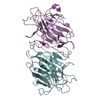 9b34MC 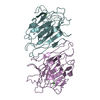 9b33C  9b35C  9b36C  9b37C 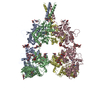 9b38C  9b39C M: atomic model generated by this map C: citing same article ( |
|---|---|
| Similar structure data | Similarity search - Function & homology  F&H Search F&H Search |
- Links
Links
| EMDB pages |  EMDB (EBI/PDBe) / EMDB (EBI/PDBe) /  EMDataResource EMDataResource |
|---|---|
| Related items in Molecule of the Month |
- Map
Map
| File |  Download / File: emd_44125.map.gz / Format: CCP4 / Size: 64 MB / Type: IMAGE STORED AS FLOATING POINT NUMBER (4 BYTES) Download / File: emd_44125.map.gz / Format: CCP4 / Size: 64 MB / Type: IMAGE STORED AS FLOATING POINT NUMBER (4 BYTES) | ||||||||||||||||||||||||||||||||||||
|---|---|---|---|---|---|---|---|---|---|---|---|---|---|---|---|---|---|---|---|---|---|---|---|---|---|---|---|---|---|---|---|---|---|---|---|---|---|
| Projections & slices | Image control
Images are generated by Spider. | ||||||||||||||||||||||||||||||||||||
| Voxel size | X=Y=Z: 1.3487 Å | ||||||||||||||||||||||||||||||||||||
| Density |
| ||||||||||||||||||||||||||||||||||||
| Symmetry | Space group: 1 | ||||||||||||||||||||||||||||||||||||
| Details | EMDB XML:
|
-Supplemental data
-Mask #1
| File |  emd_44125_msk_1.map emd_44125_msk_1.map | ||||||||||||
|---|---|---|---|---|---|---|---|---|---|---|---|---|---|
| Projections & Slices |
| ||||||||||||
| Density Histograms |
-Half map: #1
| File | emd_44125_half_map_1.map | ||||||||||||
|---|---|---|---|---|---|---|---|---|---|---|---|---|---|
| Projections & Slices |
| ||||||||||||
| Density Histograms |
-Half map: #2
| File | emd_44125_half_map_2.map | ||||||||||||
|---|---|---|---|---|---|---|---|---|---|---|---|---|---|
| Projections & Slices |
| ||||||||||||
| Density Histograms |
- Sample components
Sample components
-Entire : Concanavalin-A dimer
| Entire | Name: Concanavalin-A dimer |
|---|---|
| Components |
|
-Supramolecule #1: Concanavalin-A dimer
| Supramolecule | Name: Concanavalin-A dimer / type: complex / ID: 1 / Parent: 0 / Macromolecule list: #1 |
|---|---|
| Source (natural) | Organism:  |
| Molecular weight | Theoretical: 50 KDa |
-Macromolecule #1: Concanavalin A
| Macromolecule | Name: Concanavalin A / type: protein_or_peptide / ID: 1 / Number of copies: 2 / Enantiomer: LEVO |
|---|---|
| Source (natural) | Organism:  |
| Molecular weight | Theoretical: 25.622385 KDa |
| Sequence | String: ADTIVAVELD TYPNTDIGDP SYPHIGIDIK SVRSKKTAKW NMQNGKVGTA HIIYNSVDKR LSAVVSYPNA DSATVSYDVD LDNVLPEWV RVGLSASTGL YKETNTILSW SFTSKLKSNS THETNALHFM FNQFSKDQKD LILQGDATTG TDGNLELTRV S SNGSPQGS ...String: ADTIVAVELD TYPNTDIGDP SYPHIGIDIK SVRSKKTAKW NMQNGKVGTA HIIYNSVDKR LSAVVSYPNA DSATVSYDVD LDNVLPEWV RVGLSASTGL YKETNTILSW SFTSKLKSNS THETNALHFM FNQFSKDQKD LILQGDATTG TDGNLELTRV S SNGSPQGS SVGRALFYAP VHIWESSAVV ASFEATFTFL IKSPDSHPAD GIAFFISNID SSIPSGSTGR LLGLFPDAN UniProtKB: Concanavalin-A, Concanavalin-A |
-Macromolecule #2: ZINC ION
| Macromolecule | Name: ZINC ION / type: ligand / ID: 2 / Number of copies: 2 / Formula: ZN |
|---|---|
| Molecular weight | Theoretical: 65.409 Da |
-Macromolecule #3: CALCIUM ION
| Macromolecule | Name: CALCIUM ION / type: ligand / ID: 3 / Number of copies: 2 / Formula: CA |
|---|---|
| Molecular weight | Theoretical: 40.078 Da |
-Experimental details
-Structure determination
| Method | cryo EM |
|---|---|
 Processing Processing | single particle reconstruction |
| Aggregation state | particle |
- Sample preparation
Sample preparation
| Buffer | pH: 8 Component:
| ||||||||||||||||||||||||
|---|---|---|---|---|---|---|---|---|---|---|---|---|---|---|---|---|---|---|---|---|---|---|---|---|---|
| Grid | Model: UltrAuFoil R1.2/1.3 / Material: GOLD / Support film - Material: GOLD / Support film - topology: HOLEY | ||||||||||||||||||||||||
| Vitrification | Cryogen name: ETHANE |
- Electron microscopy
Electron microscopy
| Microscope | TFS KRIOS |
|---|---|
| Image recording | Film or detector model: GATAN K3 (6k x 4k) / Digitization - Dimensions - Width: 5760 pixel / Digitization - Dimensions - Height: 4092 pixel / Number grids imaged: 5 / Number real images: 22990 / Average exposure time: 2.5 sec. / Average electron dose: 58.0 e/Å2 |
| Electron beam | Acceleration voltage: 300 kV / Electron source:  FIELD EMISSION GUN FIELD EMISSION GUN |
| Electron optics | Illumination mode: FLOOD BEAM / Imaging mode: BRIGHT FIELD / Cs: 2.7 mm / Nominal defocus max: 2.0 µm / Nominal defocus min: 1.0 µm |
| Experimental equipment |  Model: Titan Krios / Image courtesy: FEI Company |
+ Image processing
Image processing
-Atomic model buiding 1
| Refinement | Space: REAL |
|---|---|
| Output model |  PDB-9b34: |
 Movie
Movie Controller
Controller












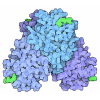
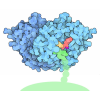
 Z (Sec.)
Z (Sec.) Y (Row.)
Y (Row.) X (Col.)
X (Col.)













































